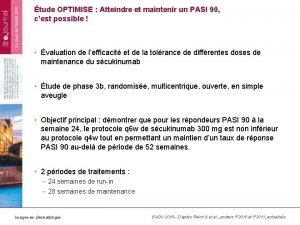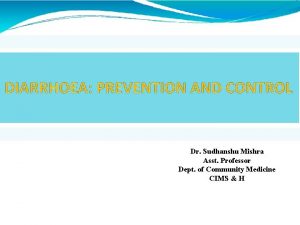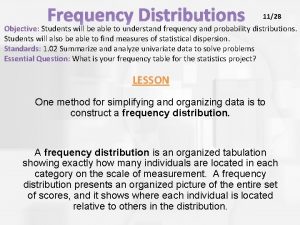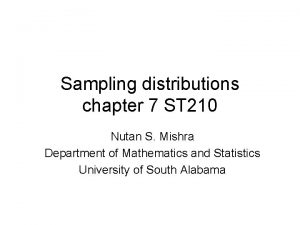Chapter 2 Organizing Data Nutan s Mishra 332021
















- Slides: 16

Chapter 2 Organizing Data Nutan s. Mishra 3/3/2021 University of South Alabama

Raw Data A data recorded in the form as it was collected without ranking or processing is called raw data. Example: consider the status of following 20 students. The four status are SO, F, J, SE 3/3/2021 J F J SO SE F SO SE This also called F J F ungrouped data. F SE SO SE J SO Alabama SEUniversity F of South SE

Grouped Data Status x F SO # of students (frequency f) 6 4 J 4 SE 6 This is categorical (qualitative) data x= status f= frequency The data set consist of 20 members. The sum of frequencies of all the categories is equal to size of the data set. i. e. Σf = f 1 + f 2 + f 3 + f 4 = 20 3/3/2021 University of South Alabama

Relative frequency Status # of students Relative Percentage x (frequency f) frequency F 6 6/20 (6/20)*100 SO 4 J 4 SE 6 4/20 6/20 (4/20)*100 (6/20)*100 Relative frequency of a category = frequency of that category/ sum of all frequencies 3/3/2021 University of South Alabama

Graphical presentation 3/3/2021 University of South Alabama

Organizing Data (quantitative) Consider the following table GPA (x) Number of This is the organized data for Students (f) the quantitative variable GPA. 0 to 1 10 The table shows that there are 10 students whose GPA 1 to 2 34 falls between 0 and 1 and … 2 to 3 40 The values of x are divided 3 to 4 16 into four distinct classes. Each class is an interval of values. 3/3/2021 University of South Alabama

Organizing Data (quantitative) This is called Frequency Distribution Table or just frequency distribution. Class width = upper boundary-lower boundary Class midpoint = (upper boundary+lower boundary)/2 3/3/2021 University of South Alabama

Construction of frequency distribution That is how to divide data into classes? How many classes? Depends on size of the data set. Vary between 5 and 20. What should be the class width? Approximately (largest value-smallest value)/number of classes 3/3/2021 University of South Alabama

Example of classification Consider the following raw data on GPA of 30 students. 1. 68 2. 35 2. 59 3. 99 2. 87 3. 23 3. 78 2. 00 2. 74 1. 54 2. 15 3. 22 1. 78 3. 66 3. 01 3. 27 2. 55 2. 29 3. 39 3. 94 3. 00 2. 75 1. 77 1. 99 3. 45 2. 28 2. 59 3. 07 2. 75 3. 07 We know that the variable GPA =x varies between 0 and 4 Number of classes can be 3 or 4 or 5. let it be 3 Then class width = (3. 99 -1. 54)/3 =. 81 1 3/3/2021 University of South Alabama

Example of classification And the frequency table is as follows x 1 to 2 2 to 3 3 to 4 f 5 12 13 r. f. 5/30 12/30 13/30 percent (5/30)*100= 16. 67 (12/30)*100= 40 (13/30)*100= 43. 33 Relative frequency of a class = frequency of that class/ sum of all frequencies = 3/3/2021 f/Σf University of South Alabama

Important note about classification Most of the statistical software accept only raw data as input and they classify data for us. Thus if we are using a software to analyze our data, we do not have to worry about the classification part. Software gives us ability to change the number and width of the classes according to the need of the problem. 3/3/2021 University of South Alabama

Cumulative frequency distribution A cumulative frequency distribution gives the total number of values that fall below the upper boundary of each class. Example: Application 2. 34 from the textbook frequency cumulative frequency Number of Checks Number of students 0 to 99 39 100 to 199 21 0 to 199 60 200 to 299 18 0 to 299 78 300 to 399 15 0 to 399 93 400 to 499 7 0 to 499 100 3/3/2021 University of South Alabama

Frequency Curve Number of Checks Modified classes Midpoint of class Number of students 0 to 99 0 1 o 100 50 39 100 to 199 100 to 200 150 21 200 to 299 200 to 300 250 18 300 to 399 300 to 400 350 15 400 to 499 400 to 500 450 7 3/3/2021 University of South Alabama

Ogive (Cumulative frequency curve) 3/3/2021 University of South Alabama

Stem and Leaf display A way of organizing and display quantitative data. Each value is divided into two parts – a stem and a leaf. To draw a stem-n-leaf plot its helpful to know the range of the data that is max value and min value If can not find out exact values of max and min, the approximate value can given us some idea about the range of the data. Consider the following data set of scores of 30 students in Statistics exam 3/3/2021 75 52 80 96 65 79 71 87 93 95 69 72 81 61 76 86 79 68 50 92 83 84 77 64 71 87 72 92 57 98 University of South Alabama

Stem and leaf display In this data set the values range between 50’s and 90’s. Thus we would like to count the number of values in 50’s, in 60’s in 70’s and so on That we declare the tenth place as stem and unit place as a leaf. Thus the resulting stem and leaf plot is as follows: Stem 3/3/2021 leaves Leaves arranged in order 5 207 027 6 59184 14589 7 591269712 112256799 8 0716347 0134677 9 635228 223568 University of South Alabama
 Semaine 332021
Semaine 332021 Nutan patel
Nutan patel Nischal mishra
Nischal mishra Dr anoop mishra herbalife
Dr anoop mishra herbalife Nina mishra
Nina mishra Smita mishra panda
Smita mishra panda Dr sudhanshu mishra
Dr sudhanshu mishra Bud mishra
Bud mishra Kalanand mishra
Kalanand mishra Kalanand mishra
Kalanand mishra Dipti mishra iiit hyderabad
Dipti mishra iiit hyderabad Cheekbone shape
Cheekbone shape Dr arvind mishra
Dr arvind mishra Dr padma mishra bhopal
Dr padma mishra bhopal Fdi notation
Fdi notation Organizing data in a traditional file environment
Organizing data in a traditional file environment Organizing data using frequency distribution
Organizing data using frequency distribution






























